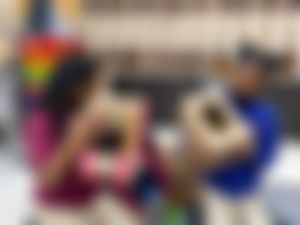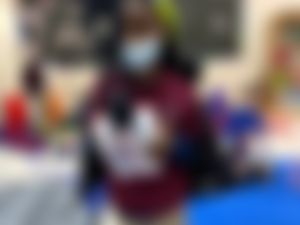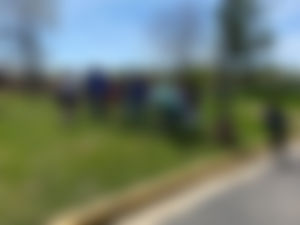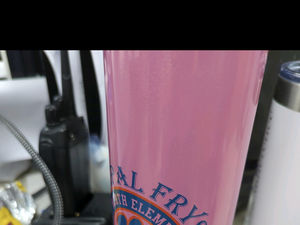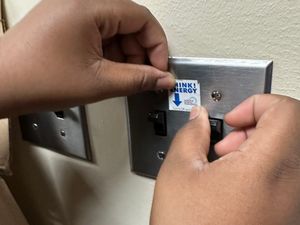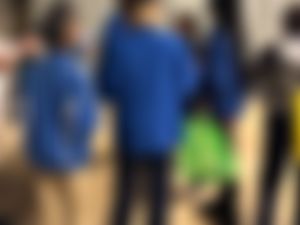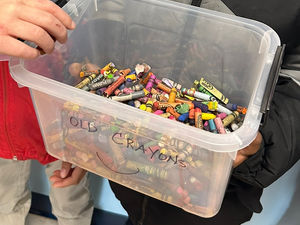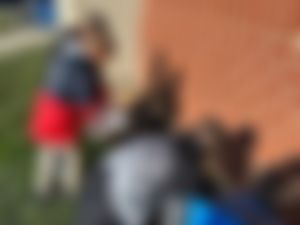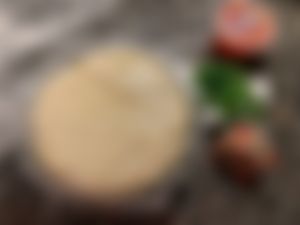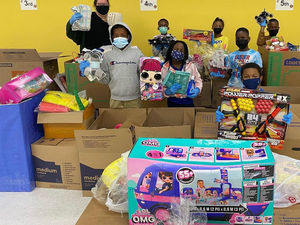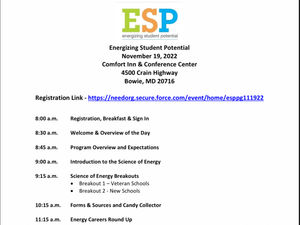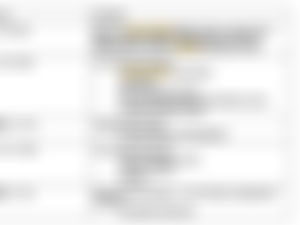Systemic Sustainability
Environmental Curriculum and Instruction
1.1 Curriculum and Instruction
Elementary & middle schools must provide one example of outdoor/environmental instruction per grade level.
High schools must provide one example of outdoor/environmental instruction in four subjects (which may include multiple different differents sciences).
Students work in the ecology lab to explore ways used materials could be used in new STEM projects. Students used repurposed materials to create cushion for the egg drop challenge. This was a learning activity that showed how we can repurpose supplies. Students enjoyed this activity. Some of the eggs were used as food for Princess Leah (our pet Tegu/lizard).
Students learn about ways to help the environment through the Counties Growing up Green program. Students got to learn about their environment. Students spent time cleaning up the environment. Students shared ways to help our environment with the school and their families. Students learn about ecosystems and create art to display what they learned.
Students raised sunfish in the Ecology class and learned about the life cycle of sunfish. Students monitored the PH levels of the water to ensure the environment was appropriate for the fish. Fish were to be released into Potomac River, however due to quarantine they had to be released locally.
Students participated in the counties online Camp Schmidt program. They learned about animal habits. They learned to help the environment. Students made a word wall during a virtual Camp Schmidt field trip sharing words that are important to environmental literacy.
In Music Class students studied vibrations, resonance, and all that's needed to make different instruments "play". Parents donated old materials to be reused for a STEM project. Each student created an instrument entirely of their own design! Students learned how to repurpose materials.
Recycled materials were used to create instruments for a musical concert. They looked around the house and emptied classroom recycling bins for recyclable materials and "trash" to create instruments of our own design following our individual instrument plans. The image shows students and their recycled material instruments.
Students and their instruments.
Students and their instruments.
Students and their instruments.
Students explored animal habitats by listening to the story of three little pigs. Then they used recycled materials to create a sturdy habitat for the pigs.
Students collected and used recycled materials, in order to discover which type of ramp would cause a ball to roll the farthest distance.
Students sorted recycling game. Students sort trash, into the appropriate containers. Students enjoyed working to see what items can be recycled.
EarthDayRecyclingSortingGame (1.39 MB)
This is the printable template for the sorting game.
Germinating seeds in a bag is a fun way for kids to view how seeds transform into plants right before their eyes. Seeds don’t need soil to start germinating, so you can place them in a sunny window and they will start sprouting right away. This allows kids to watch how seeds sprout, which is a process normally hidden by dirt. There is a lot to learn in this experiment, yet it is so simple to do! As long as you have dried beans and some plastic bags.
This lesson is about taking care of the earth. Students had a discussion about littering and what can be done to help the environment as a whole. One solution was to clean up trash we see in our yards, neighborhoods, and at school. Students were provided rubber gloves and went around the school picking up trash.
Students used old materials to make balloon powered car. Students learned about alternative energy sources. Students learn ways to repurpose supplies.
Students used old spoons and old popsicle sticks that fell on the floor to create catapults. Instead of discarding the spoons and popsicle sticks they were repurposed to teach students about potential and kinetic energy as well as simple machines.
In collaboration with the Port of Baltimore, students got to learn about erosion. Students learned about how erosion disrupts the environment for the Diamond Back Terrapin. Students got to have a dialogue about the turtles.
Diamonds in the Bay (updated 11.14.22) (383.01 MB)
The actual lesson students got on Erosion and Turtles.
During this program students will learn about WSSC’s work to protect the Patuxent River reservoirs, the drinking water source for 1/3 of WSSC’s customers.
1.2 Green School Awareness
1.2.1 School Wide Awareness - Staff
Demonstrate that all school personnel are aware of your school's Green School status and application process.
As the Green school leaders we ensure all staff members are aware of our Green School Efforts. We have staff meeting biweekly were we share out updates and expectations. We also host an annual Earth day event where all teachers conduct Environmentally friendly activities.
Bi-Weekly Staff meeting. Teachers learn about our Green School application resubmission. Teachers learn about our initiatives including trash free lunch days. Teachers are invited to share their Green ideas. Teachers are reminded to conserve energy in their classrooms. Teachers are also trained on caring for their in class Aero Gardens.
These are the meeting agenda and notes from a staff meeting on 12/7. This meeting talked about some of our new Green School initiatives which included our new Aero Gardens from DonorsChoose. We shared news about our upcoming trash free lunch day. We also informed teachers about the new spider plants they would be receiving as well as discussed care instructions and student participation.
1.2.2 School-Wide Celebration
Demonstrate how your school celebrates beig a Green School by hosting a school-wide environmentally-focused event open to all students.
CMIT NES scholars have several opportunities to learn about their environment. They participate in fun and exciting environmentally friendly activities. They participate in some environmentality friendly competeition. Students participate in MESA, Kidswind, and Kiwanis clubs which all are Green friendly clubs.
Students love to participate in our recycled costume word parade! Students pick their favorite STEM word and use old materials to create a costume. This has become a school wide tradition. Students learn to be environmentally aware off ways they can help the environment.
All Students and Staff gather, to celebrate all of their hard work, raising butterflies, planting gardens, and learning about their lifecycle. They gather and release the grown butterflies into nature.
Environmental Professional Development for Teachers
1.3.1 Environmental Professional Development for Teachers
Demonstrate that 10% of staff have completed an environmental PD. Instructional staff is defined as any staff that manages a gradebook.
- New Schools must have all PD completed within the past 2 academic years.
- Renewing schools must have all PD completed within the past 4 academic years.
A teacher who has participated in multiple workshops may only be counted once..
Several staff members have attended professional developments. We have participated in the Need program over the past 5 years. We participate in Mathematics Engineering and Science achievement Trainings through John Hopkins. We participate in Kiwanis kids which is a training for Go Green club. We have a staff member in her graduate program for Environmental education. We have participated in Camp Schmidt since the school opened.
Energizing Students Potential training. This training provides training on ways to conserve energy. The training provides resources to teach students about energy conservation. The NEED program has grants for. the school to host energy fairs.
Ms. Avsar has attended multiple energy training.She has worked with ESP (NEED) to learn skills to create Green conscience citizens. She works with students to teach them about the environment. She uses technology to ensure students reach ways to help their environment.
ESP PD- 02_05_22 (229.28 KB)
Energizing student potential workshop Avsar.
Attended: Green Team Meeting and PD for Schools May 22 8:30 Patuxent River Park. Teachers were introduced to different environmental concepts, previewed field learning opportunities for students, and kayaked in the Patuxent River looking for wildlife.
certificate-of-completion (73.23 KB)
MD Green School Program - A Beginner's Guide 8/24/ 22
certificate-of-completion (1) (71.26 KB)
Green Team Meeting and PD for Schools May 22 8:30 Patuxent River Park.
Community Scientist Class. (aka collecting data for various programs so they can have data for their studies—I am doing this now on maple trees.
Ms. Barton is currently obtaining a Master's degree in Environmental Education
Transcript (SU22) copy (1.2 MB)
Transcripts showing competition of several environmental science courses.
Confidence course training with Green School Component: Hosted by the Schmidt Center, this PD gives participants an overview of the Maryland Green School Program and trains staff how to facilitate the Confidence Course (high ropes) lesson during the 5th Grade overnight trip.
1.4 Achieving Sustainable Schools
1.4.1 School-Wide Staff Sustainability
Demonstrate the sustainability practices your teachers, staff, and other personnel have implemented school-wide to make your school green. Any actions involving students belong under Objective 2.
-
The students and administration chose to cut off the water fountains. Instead, entire school uses refillable bottles instead of single-use plastic bottles. Staff and students are all using reusable water bottles.
-
Transitioned from using traditional trifold boards for the STEM Fair to a virtual fair.
-
Host trash free lunch days.
-
Transition to online work.
-
Student lead environmental efforts to keep the school grounds clean.
Staff and students create reusable water bottles. Staff and students can design and create their own custom bottles. Students work together to create cool designs and then print them and sublimate them on their bottles. This was a design they made for our principal.
Sun Ray All Day! - Miracle Wigfall__20230212200296 (824.73 KB)
Virtual STEM Fair Projects are mandated by the school's STEM Committee for all students. Students use Google slides or other virtual means instead of trifold boards. This helps reduce waste.
1.4.2 Systemic Partnership
Demonstrate one partnership with a central office or board within the school system that supports part of the Maryland Green Schools Program. Any partnerships outside of your school system belong under Objective 3.
We partner with the PGCPS Building Services with the Office of Recycling each year to complete a waste reduction plan.
CMIT NES Waste Reduction Plan 22-23 Signed (1) (64.82 KB)
22-23 Waste Reduction Plan - This waste reduction plan helps to reduce the number of things wasted. This plan shows how we minimize food waste, reduce trash waste, and reduce energy use.
Student Action
Schools must document eight total actions that address at least three of the listed sustainability practices.
These are student actions not adult actions. Adult sustainable actions can be documented in Objective 1.4.
2.1 Water Conservation/Pollution Prevention
2.1 Water Conservation/Pollution Prevention
The Green Team Students Partnered with the Schmidt Center, to have our students label our storm drains to remind everyone that the storm drains lead to the Chesapeake Bay.
During this field trip to WSSC, students learned about WSSC’s work to protect the Patuxent River reservoirs, which holds the drinking water for 1/3 of WSSC’s customers, including all of the northern CMIT schools. Students rotated through 3 activities during their time on site. This new information and hands-on experience led to the students returning to school and advocating for personal reusable water bottles and water fillers at school. They were successful. Each grade level got a reusable, personalized bottle and the school got water filling stations.
During this program students will learn about WSSC’s work to protect the Patuxent River reservoirs, the drinking water source for 1/3 of WSSC’s customers. Students will rotate through 3 activities during their time on site. This lead students to advocating for students water bottles.WSSC Lesson Plan for students environmental understanding.
This is on of our refillable water stations. This one station has save over 10,000 bottles of water. This fountain is used with reusable water bottles.
2.2 Energy Conservation
2.2 Energy Conservation
Students participated in an annual energy audit. They look for ways to conserve energy at the school. They surveyed the building and reported their findings to the program coordinator, including suggested modifications. Students suggested that we raise awareness of lighting use, and remind classrooms to shut off lights when not in use.
Students conducting the energy audit. Students learning about energy conservation.
Students learning ways to help the school be energy conscious. Students learning how to use equipment to detect energy use at the school.
Students putting up signs to remind the school to turn the lights off when the room is not in use.
2.3 Solid Waste Reduction
2.3 Solid Waste Reduction
Before completing a yearly County required Waste Reduction Plan, students conduct an in-house audit of our school's energy reduction and recycling efforts. In addition to an energy audit, students took inventory about the current status of recycling. After conducting the audits, students reflected on the findings and then brainstormed ways to encourage the school to reduce, reuse and recycle more. Students then gave input to our school wide plan.
Students collected used/broken markers donated them to the Crayola Education Recycling Program. All of those markers are diverted away from our local landfill and returned to Crayola for processing.
In order to cut down on landfill waste, students place extra unopened lunch on the share table to be used for snacks later.
2.4 Habitat Restoration
2.4 Habitat Restoration
Students watch the life cycle if the painted lady butterfly. Students and the community work together to plant a butterfly garden. This helps attract pollinators. Students also make butterfly feeders. Students later celebrate by releasing the butterflies back into the environment.
2022 Butterfly lifecycle project (564.59 KB)
CMIT Butterfly Lifecycle Unit Plan developed by our STEAM Committee.
2.5 Opportunities for Nature Exploration
2.5 Opportunities for Nature Exploration
Students create outdoor learning space by setting tables for learning. Students went on nature hikes, had outdoor lunch, and explored animals in their environments.
Second Grade is doing their part to help beautify the outdoor learning space by planting tulips. They collected data by making observations and measuring their growth.
2.6 Responsible Transportation
2.6 Responsible Transportation
Students researched signs to purchase to start a no idle zone. Students provide link for no idle zone signs for the school to purchase. Students create their own No Idle zone signs to help decrease pollution.
2.7 Healthy Indoor Environments
2.7 Healthy Indoor Environments
Each office and classroom received a AeroGarden to grow fresh vegetables or herbs in their classrooms. Students were put in charge of feeding, trimming, maintenance and harvesting. Students learned all about their specific plants (vegetable or herb) and how to prepare and eat them.
2.8 Citzen/Community/Participatory Science
2.8 Citizen/Community/Participatory Science
Students plant Tulip Gardens, and track their emergence and bloom. They then submit the information online to the Journey North.
Community Partnership
Demonstrate that your school is forming long-term partnerships to foster environmental stewardship and cultivate community wellness through real-world connections.
3.1 Community Partnerships
3.1.1 School Active in Community
Describe at least one environmentally-focused partnership in which your school is working to benefit your community.
We collected reusable water bottles, tubberware, toys, covid supplies, blankets and more. These supplies were delivered to homeless people in Prince George's County. We also delivered to LARS a local community organization. Toys were picked up by Toys for Tots.
We also have partnerships will Esp Need program. They provide resources and professional developments to promote energy efficiency knowledge amongst stakeholders.
3.1.2 Community Active in the School
Describe at least one partnership in which a community partner is benefitting the school. These actions and projects occur on or near school grounds with support from the partner.
Each year we partner with the PGCPS office of recycling to promote a reduction of waste. Recycling bins are in each room of the school. Students are encouraged to recycle.
The 5th grade scholars took part in the virtual camp schmidt trip. Students enjoy learning about the environment. They practice recycling. They learn about the deer population and how to identify their poop. They learn how deer poop can be used as fertilizer for plants.
PGCPS Mail - Virtual Camp Schmidt Follow Up (107.16 KB)
Follow Up email from the Schmidt Center from our 5th Grade Virtual Field Trip
3.2 Additional Achievements
3.2 Additional Achievements optional
Share any environmentally-related awards, special recognition, certifications, or other achievements that your school, staff or students have accomplished.
Student’s participation in a serious of STEM challenges. For the storybook Themepark ride they have to create an amusement park ride that is-made of 50 % recycled materials. They selected the book Smile. They won first place in the regional competition.

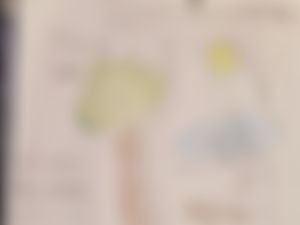

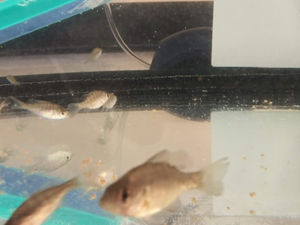

__20230208204894.jpg)
